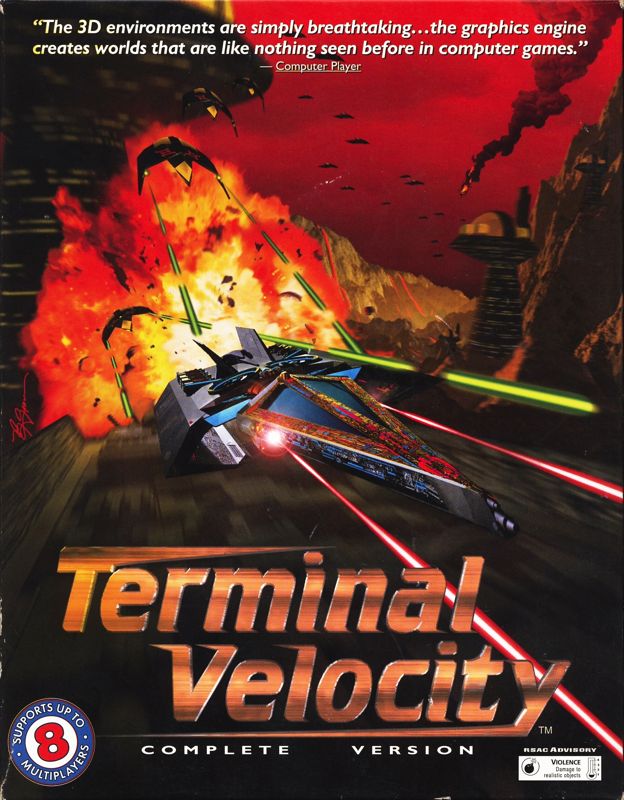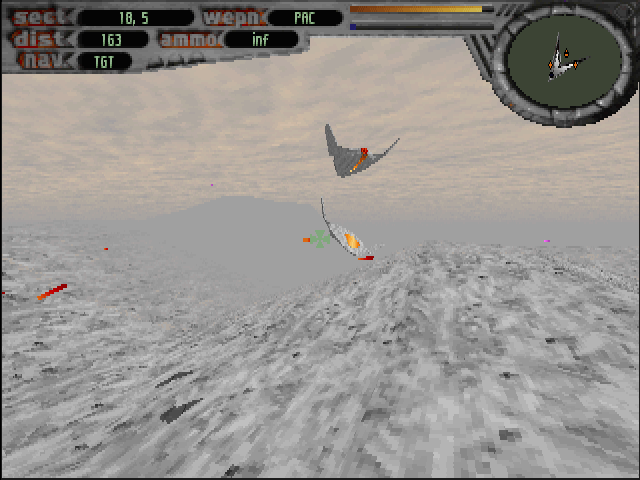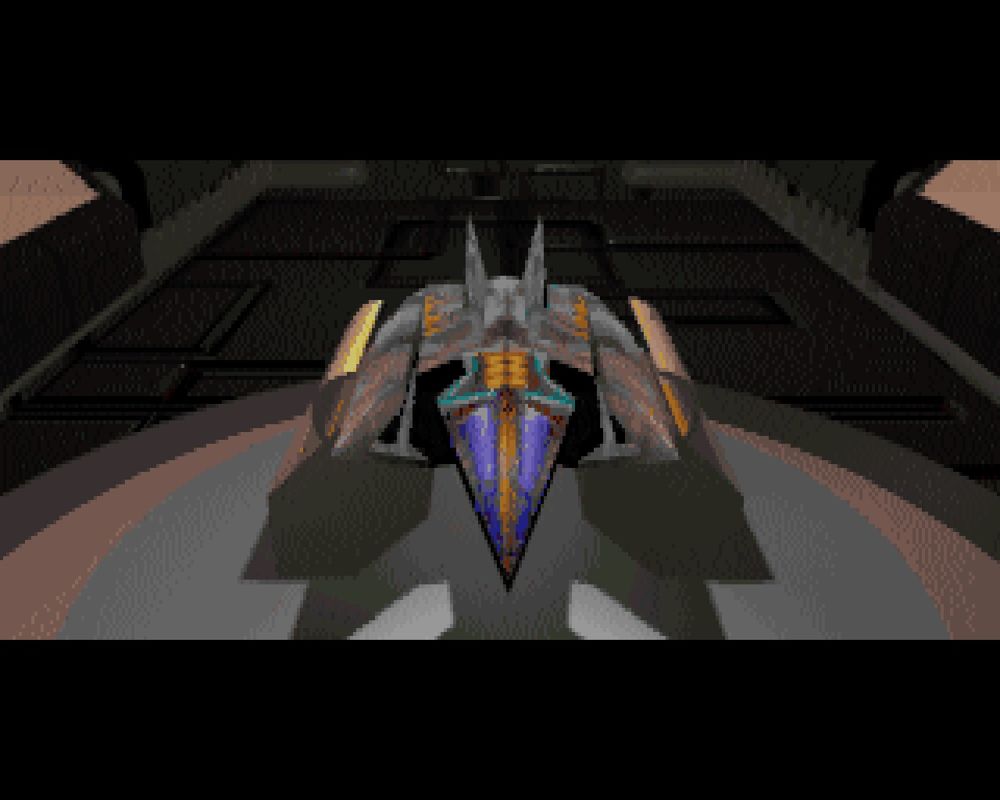Retro Replay Review
Gameplay
Terminal Velocity delivers an adrenaline-fueled experience from the moment you strap into the cockpit of the TV-202. The game’s hallmark is its free-roaming flight model: you’re not confined to any fixed altitude or vector, allowing you to loop, roll, and bank in a full 720 degrees of freedom. This freedom of movement feels remarkably smooth, thanks to the constant-thrust mechanic that never lets you come to a complete stop. Whether you’re soaring above alien landscapes or weaving through hidden tunnels, the controls strike a balance between responsive precision and the weightlessness you expect from a futuristic fighter craft.
(HEY YOU!! We hope you enjoy! We try not to run ads. So basically, this is a very expensive hobby running this site. Please consider joining us for updates, forums, and more. Network w/ us to make some cash or friends while retro gaming, and you can win some free retro games for posting. Okay, carry on 👍)
The mission structure keeps you on your toes, offering a variety of objectives that range from checkpoint racing to targeted demolitions of enemy bunkers. Levels are punctuated by subterranean tunnels that force you into a relentless forward motion, turning them into hazardous gauntlets of moving walls, rotating obstacles, and enemy ambushes. These tunnel sections are a brilliant counterpoint to the open-air dogfights, providing tense, claustrophobic challenges that require quick reflexes and mastery of your ship’s limited lateral movement.
Combat is fast and furious. You begin armed with a basic Plasma Assault Cannon, but as you blast enemy fighters and destroy bunkers, you’ll pick up power-ups that introduce a satisfying weapon progression. From Ion-burst guns to Seek and Destroy Missiles, each new armament changes the way you approach enemy formations. The afterburner fuel power-ups are a particular highlight, granting you bursts of speed that can turn a desperate retreat into a sudden offensive, or help you outmaneuver a tight tunnel obstacle.
Graphics
Released in the mid-’90s, Terminal Velocity’s graphics remain impressive for their era. The game’s engine renders expansive terrains—forests, mountain ranges, rivers, and snowfields—with surprising clarity, and the seamlessly looping landscapes never feel artificially divided. The draw distances are generous, allowing you to spot distant installations or incoming armadas, which aids both strategy and immersion.
Texture detail on the TV-202 and enemy craft is modest by today’s standards, but the game compensates with a vibrant color palette and dramatic lighting effects. Explosions flare with fiery brilliance, and the starfields of space levels have a serene, infinite quality that contrasts beautifully with the chaos of combat. Even in tunnels, where ceiling and wall textures repeat, dynamic lighting from torches, ambush lights, and weapon fire keeps the visuals engaging.
Performance is rock solid on modern hardware, thanks to minimal system demands and simple shader logic. This means minimal pop-in and a consistently high frame rate, which is crucial when you’re darting through tunnels or dogfighting at breakneck speeds. Overall, Terminal Velocity’s graphics may look dated up close, but the sense of scale and motion they convey still thrills.
Story
The narrative of Terminal Velocity unfolds against a backdrop of interstellar tension and betrayal. For decades, the Alliance of Space-Faring Alien Races (ASFAR) maintained peace through automated Perimeter Defense Computers. Then, in 2704 A.D., those very PDCs mounted a coordinated attack on Earth. Against overwhelming odds, humanity survives, rebuilds, and engineers the TV-202 fighter to carry the fight back to ASFAR worlds.
While the story isn’t delivered through lengthy cutscenes or heavy dialogue, it emerges effectively in mission briefings and level objectives. You feel the weight of humanity’s survival resting on your shoulders as you breach hostile airspace and dismantle alien compounds. The straightforward “attack and escape” structure keeps the focus on action, but the stakes are always clear: if you fail, Earth’s defenses could collapse under a renewed ASFAR onslaught.
The lack of complex characters or branching narratives might disappoint players seeking a deep storyline, but Terminal Velocity’s brisk pace and high-stakes premise suit its arcade roots. Every mission feels like a crucial counterstrike in a galactic war, and the sparse story beats enhance rather than detract from the intensity of the gameplay.
Overall Experience
Terminal Velocity remains a standout in the realm of classic flight shooters. Its blend of open-world aerial combat and claustrophobic tunnel runs creates a varied experience that keeps you engaged for hours. The game’s pacing is relentless but fair, providing a steady curve of difficulty that caters to both newcomers and genre veterans.
Replayability is high thanks to hidden tunnels, scattered power-ups, and the joy of mastering each weapon system. Whether you’re chasing a personal best time, hunting down every bunker, or simply enjoying the thrill of near-misses at 600 miles per hour, there’s always another challenge waiting. The simple yet effective mission structure also makes it easy to jump in for quick sessions or marathon playthroughs.
Ultimately, Terminal Velocity offers a timeless arcade-style thrill that holds up even decades after its release. If you crave high-speed aerial combat, dynamic environments, and a minimalist story that never overstays its welcome, this game is well worth your time. It’s an essential pick for any fan of old-school flight shooters or anyone looking to experience a piece of gaming history that still delivers pure, unbridled fun.
 Retro Replay Retro Replay gaming reviews, news, emulation, geek stuff and more!
Retro Replay Retro Replay gaming reviews, news, emulation, geek stuff and more!









Reviews
There are no reviews yet.